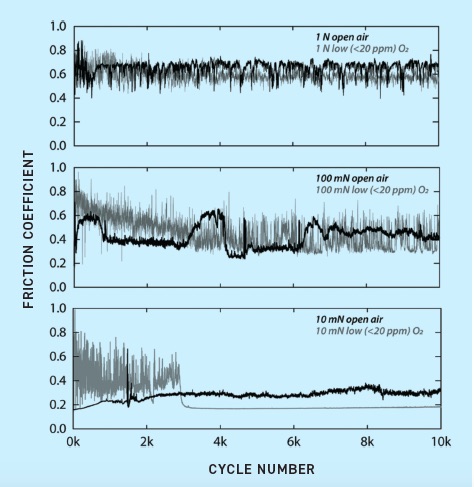Notorious BMG
Drs. Wilfred T. Tysoe & Nicholas D. Spencer | TLT Cutting Edge April 2021
Friction on bulk metallic glasses has been investigated by many researchers. Unfortunately, the results vary considerably.
Bulk metallic glasses (BMGs) are fascinating materials. Being amorphous alloys, devoid of the grain structures associated with metals, they show superplasticity, high fracture toughness and extraordinary strength. They also have remarkable elasticity, which has led to an exotic application in golf clubs. The dislocation mechanisms responsible for plasticity in crystalline metals are replaced by shear banding or viscous flow (depending on temperature and shear rate) in BMGs. At elevated temperatures, they have a tendency to crystallize.
One might expect that the unusual bulk structure and properties should lead to interesting tribological properties, too, and these have indeed been heavily investigated since the early 1980s. Unfortunately, the literature data for both friction and wear are highly divergent, with μ values ranging from 0.1 to >0.5 and wear coefficients varying by two orders of magnitude.
Morgan Jones and Drs. Andrew Kustas, Ping Lu, Michael Chandross and STLE member Nicolas Argibay from Sandia National Laboratories in Albuquerque, N.M., have tried to bring some order into this disordered (or even amorphous) situation.
1 For their experiments, they used Vitreloy 1b, which has the unmemorable formula of Zr
44Cu
10Ni
10Ti
11Be
25. Many of the previous studies with similar materials were carried out under macroscopic loads, and the authors suspected that this could lead to significant frictional heating, which, in turn, could cause crystallization, oxide growth or even melting and viscous flow. For this reason, they investigated a range of loads from 10 mN to 1 N, and carried out sliding experiments (reciprocating, against a sapphire ball) under either ambient air or nitrogen (<20 ppm oxygen).
The results (
see Figure 1) show that at higher loads the friction coefficient is indeed high and noisy, but at the lowest load (10 mN) and oxygen concentration, there seems to be a transition to a steady, low-friction-coefficient value, after about 3,000 cycles. Using the Bowden-Tabor relation for fully plastic contacts, the authors calculated the predicted friction coefficient to be 0.19, which is remarkably similar to their experimentally obtained value. In other words, it seemed that the low-load, low-oxygen case was representative of the bulk metallic glass itself, free of oxidation or crystallization effects. The lack of surface oxidation, in this case, (thanks to low-oxygen concentration and lack of significant frictional heating) was confirmed by backscattering scanning electron microscopy, and energy-dispersive spectroscopy showed that all other loads and environments studied involved the formation of significant amounts of mixed-metal oxides.
 Figure 1. Average friction coefficient as a function of cycle number for a sapphire sphere sliding against a Zr44Cu10Ni10Ti11Be25 BMG with a range of normal (contact) forces in laboratory air and low-O2 (< 20 ppm) environments. Reproduced by kind permission of Springer-Nature.1
Figure 1. Average friction coefficient as a function of cycle number for a sapphire sphere sliding against a Zr44Cu10Ni10Ti11Be25 BMG with a range of normal (contact) forces in laboratory air and low-O2 (< 20 ppm) environments. Reproduced by kind permission of Springer-Nature.1
Cross-sectional (FIB) analysis by high-angle annular dark-field scanning transmission electron microscopy showed that at a 10 mN load, there was no evidence of crystallization. In lab air, there was significant formation of mixed oxides, while in the low-oxygen case there was only a very thin oxide layer present, suggesting that the friction results at low load in low oxygen are representative of the BMG itself, but also implying that measurements in ultrahigh vacuum might be useful for future studies!
The authors’ survey of the literature data shows that the overwhelming majority of BMG tribology studies have been operating under conditions where a mixed metal oxide has been present, i.e., the results are not characteristic of the BMG itself. With a combination of simple tribological measurements under stringent environmental conditions and the judicious use of sophisticated microscopic approaches, the authors have shown that the frictional behavior of these materials does appear to be quite predictable and straightforward.
The wear behavior is a story for another time!
FOR FURTHER READING
1.
Jones, M.R., Kustas, A.B., Lu, P., Chandross, M. and Argibay, N. (2020), “Environment-dependent tribological properties of bulk metallic glasses,”
Tribol Lett, 68, 123. Available
here.
Eddy Tysoe is a distinguished professor of physical chemistry at the University of Wisconsin-Milwaukee. You can reach him at wtt@uwm.edu.
Nic Spencer is professor of surface science and technology at the ETH Zurich, Switzerland, and editor-in-chief of STLE-affiliated Tribology Letters journal. You can reach him at nspencer@ethz.ch.